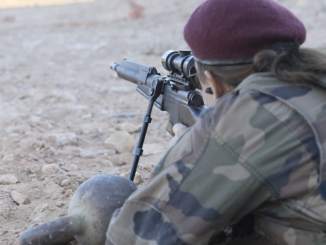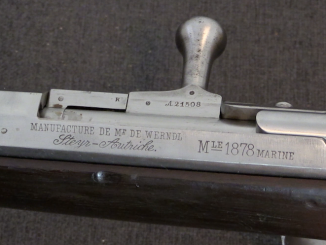While the French military adopted a .22 rimfire training version of the MAS-36, that rifle (the “Tir Réduit 5.5mm”) was intended for military training, and not for formal competition. During World War Two, the design shop as MAS continued working on rimfire designs, and developed an experimental version with a much improved trigger. This was not adopted by the military, but the parts were used after the war in 1947 to build a run of 200 competition rifles for FUSTAN – the Fédération des Unions et Sociétés de Tir d’Afrique du Nord. That is, the Federation of North African shooting societies.
This model of MAS 36 is a single shot, .22 rimfire with a finely adjustable rear aperture sight. It has a very nice trigger and a tube in place of the bayonet for adding weight to set the precise balance of the rifle. The French junior shooting champions of 1948, 1949, and 1950 used the FUSTAN MAS-36, in fact. Only a small number survive today, and it was great to be able to show this one to you!




As a collector of small bore military training rifles, this really peaked my interest. “Rare” would be an appropriate description.
If the front sight is windage adjustable why is the rear sight windage adjustable as well. I think the screw on the front sight is a clamp to hold the front sight to the barrel.
@Marvib J Fritts A windage adjustable rearsight is much more user friendly for civilian target shooting shooting than an windage adjustable foresight. That’s both convenience when shooting, and quite likely precision. With a windafe adjustable rearsight, when wind’s picked up, just give it two clicks left, rather than breaking out the clamp-screw gadget, and hoping you turned it juuussst right.
“…when wind’s picked up, just give it two clicks left…”(С)
Not certainly in that way.
Target rifles in 22LR are so accurate that the inevitable changes in the uniformity of each subsequent shooting position cause such a noticeable deviation of the center of hits from the center of the target that a new zeroing is required before each valid shooting.
And there is no wind in the 50-meter shooting galleries.
@ Stiven, no, just no. Windage adjustable rearsights were standard on competition rifles well before this time. With experience competition shooters do make sight adjustment between scoring shots, without firing sighting shots (competition rules don’t always allow this – contemporary UIT rules allowed sighters after every string of 10 shots). Some prefer to aim off-centre in rapidly changing wind, but this is often less precise than clicking the rearsight. if your rearsight is so poorly made/worn that it won’t adjust consistently you find another.
Adjusting the rearsight does affect the position of the head on the stock, but for small adjustments shooters learn to deal with it.
Oh, and 50m ranges do often have wind. Some are wholly indoors, but many are not.
It’s hard to see the front sight attachment details. Loosening the front sight screw to replace the current blade with a wider or narrower blade makes more sense. My old target Remington came with a similar rear sight an a Lyman hooded front sight, that has with a tin containing a number of different front blade types and widths to use depending on the shooter and lighting conditions. Just sayen. Bob
I do not think so.
For sporting ring scopes this makes sense, but not for stump.
It would be too troublesome, and also fraught with a violation of the stability of the aiming system.
But why they did not use a stump with a small groove (which Ian praises so much) is not clear…
Look closely at the groove that is at a right angle to the screw. You will see the groove (channel) is all the way too the O.D. of the barrel. That allows the sight to collapse around the barrel thus locking it to the barrel. A common and cheap way to lock a sleeve to a shaft. Look at Hornady lock rings for reloading dies, same idea.
Look closely
https://youtu.be/89y8o4q-0GM?t=100
Maybe enough wishful thinking is enough?
Or, simply, should you buy new glasses?.. 😉
As this year was the 85th birthday of the MAS 36 the french gun magazine GAZETTE DES ARMES has been publishing a number of articles on all the different variants of this rifle